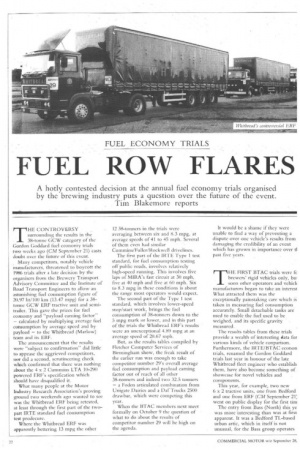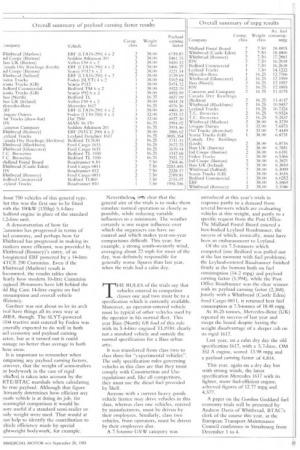FUEL ROW FLARES
Page 24

Page 25

If you've noticed an error in this article please click here to report it so we can fix it.
A hotly contested decision at the annual fuel economy trials organised by the brewing industry puts a question over the future of the event. Tim Blakemore reports
'HE CONTROVERSY
T
. surrounding the results in the
38-tonne GCW category of the Gordon Goddard fuel economy trials two weeks ago (CM September 21) 'casts doubt over the future of this event. . Many competitors, notably vehicle . manufacturers, threatened to boycott the 1986 trials after a late decision by the organisers from the Brewery Transport Advisory Committee and the Institute of Road Transport Engineers to allow an astonishing fuel consumption figure of 20.97 lit/100 kin (13.47 mpg) for a 38tonne GCW ERF tractive unit and semitrailer. This gave the prizes for fuel economy and "payload earning factorcalculated by multiplying average fuel consumption by average speed and by payload — to the Whitbread (Marlow). team and its ERF.
The announcement that the results were -subject to confirmation" did little to appease the aggrieved competitors, nor did a second, scrutineering check which confirmed that there was nothing about the 4 a 2 Cummins LTA 10-290 powered ERF's specification which should have disqualified it.
What many people at the Motor Industry Research Association's proving ground two weekends ago wanted to see was the Whitbread ERF being retested, at least through the first part of the twopart IRTE standard fuel consumption test prodecurc.
Where the Whitbread ERF was apparently bettering 13 mpg the other 12 38-totincrs•in the trials were averaging between six and 8.3 mpg, at average speeds of 41 to 45'mph. Several of them even had similar Cummins/Fuller/Rockwell drivelines.
The first part of the IRTE Type I test standard, for fuel consumption testing off public roads, involves relatively high-speed running. This involves five laps of MIRA's fast circuit at 30 mph, five at 40 mph and five at 60 mph, Six to 8.3 mpg in these conditions is about the range most operators would expect.
The second part of the Type 1 test standard, Which involves lower-speed stop/start work, brings the fuel consurription of 38-tonners down to the 5 mpg mark or lower, and in this part of the trials the Whitbread ERF's results were an unexceptional 4.89 mpg at an average speed of 2067. mph.
But, as the results tables compiled by Fletcher Computer Services of Birmingham show, the freak result of the earlier run was enough to take competitor number 29's overall average fuel consumption and payload, earning factor out of reach of all other 38-tonners and indeed two 32.5 tonners — a Foden articulated combination from Unigate Dairies and a Daf Trucks 2500 drawbar, which were competing this year.
When the BTAC: members next meet formally on October 9 the question of what to do about the results of competitor number 29 will be high on the agenda. It would be a shame if they were unable to find a way of preventing a dispute over one vehicle's -results from damaging the credibility of an event which has grown in importance over tl past five years.
T. HE FIRST BTAC trials were fc brewers' rigid vehicles only, bu:
soon other operators and vehich manufacturers began to take an interest .What attracted them was the exceptionally painstaking care which is taken in measuring fuel consumption accurately. Small detachable tanks are used to enable the fuel used to be weighed, and its specific gravity measured. .
The results tables from these trials provide a wealth of interesting data for various kinds of vehicle conparison. Furthermore, the IRTE/BTAC econon trials, renamed the Gordon Goddard trials last year in honour of the late Whitbread fleet engineer who establish. them, have also become something of. showcase for novel vehicles and components.
This year, for example, two new 6 x 2 tractive units, one from Bedford and one from ERF (CM September 21; went on public display for the first tiro The entry from Bass (North) this ye was more interesting than was at first apparent. It was a Bedford TL-based urban artic, which in itself is not unusual, for the Bass group operates .bout 750 vehicles of this general type. 3ut this was the first one to be fitted vith the 100kW (135hp) 5.4-litre 3edfOrd engine in place of the standard I.2-litre unit.
A demonstration of how far
L'unimins has progressed in terms of 'uel economy, and perhaps how far X/hitbread has progressed in making its milkers more efficient, was provided b) X/hitbread (Romsey)'s entry, of an i-registered ERF powered by a 14-litre .4'FCE 290 Cummins. Even if the X/hitbread (Marlow) result is
liscounted, the results tables show learly how modern 10-litre Cummins ngined 38-tonners have left behind the ■ Id Big Cam 14-litre engine on fuel onsumption and overall vehicle fficiency.
Gardner was not about to let its arch ival have things all its own way at AIRA, though. The 6LYT-powereci 104 tractive unit entered by Foden was ;enerally expected to do well in both .uel economy and payload earning actor, but as it turned out it could nanage no better than average in both hese areas.
It is important to remember when omparing any payload earning factors, towever, that the weight of semi-trailers or bodywork in the case of rigid -chides) is taken into account by the RTE/BTAC marshals when calculating he true payload. Although that figure itimately determines how efficient any ;nods vehicle is at doing its job, for neaningful comparison it would be nore useful if a standard semi-trailer or .ody weight were used. That would at .ast help to identify the contribution to chicle efficiency made by special ghtweight bodywork, for example.
NeverthelesA itoirs clear that the general aim of the trials is to make them simulate normal operation as closely as possible, while reducing variable influences to a minimum. The weather certainly is one major influence over which the organisers can have no control and which makes year-on-year comparisons difficult. This year, for example, a strong south-westerly wind, averaging about 22 mph for most of the day, was definitely responsible for generally worse figures than last year, when the trials had a calm day.
THE RULES of the trials say that vehicles entered in competitor classes one and two must be to a specification which is currently available. Moreover, an operator-entered vehicle must be typical of other vehicles used by the operator in his normal fleet. This year Bass (North) fell foul of this rule with its 5.4-litre erigined TL1930: clearly not a standard vehicle and outside the normal specification for a Bass urban artic.
It was transferred from class two to class three for "experimental vehicles". The only specification rules governing vehicles in this class are that they must comply with Construction and Use regulations and, like all competitors, they must use the diesel fuel provided by Shell.
Anyone with a current heavy goods vehicle licence may drive vehicles in this class, whereas class one vehicles, entered by manufacturers, must be driven by their employees. Similarly, class two vehicles, from operators, must be driven by their employees also.
A 7.5-tonne GVW category was introduced at this year's trials in response partly to a demand from several brewers which are evaluating vehicles at this weight, and partly to a specific request from the Post Office. The Midland Postal Board entered a box-bodied Leyland Roadrunner, the success of which, ironically, must have been an embarassment to Leyland.
Of the six 7.5-tonners which competed (one Bedford was pulled out at the last moment with fuel problems) the Leyland-entered Roadrunner finished firmly at the bottom both on fuel consumption (14.2 mpg) and payload earning factor (1,994), while the Post Office Roadrunner was the clear winner with its payload earning factor (2,368). Jointly with a Whitbread (Castle Eden) Ford Cargo 0811, it returned best fuel consumption at 7.5-tonnes of 18.48 mpg.
At 16.25 tonnes, Mercedes-Benz (UK) repeated its success of last year and swept the board despite having the weight disadvantage of a sleeper cab on its rigid 1617.
Last year, on a calm dry day the old specification 1617, with a 5.7-litre, OM 352 A engine, scored 13.98 mpg and a payload earning factor of 4,814.
This year, again on a dry day but with strong winds, the latest specification Mercedes 1617 with its lighter, more fuel-efficient engine, achieved figures of 12.77 mpg and 4,577.
A paper on the Gordon Goddard fuel economy trials will be presented by Andrew Davis of Whitbread, BTAC's clerk of the course this year, at the European Transport Maintenance Council conference in Strasbourg from December 1 to 4.




























































































